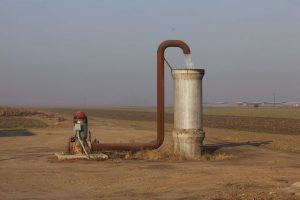It’s been a good winter for drought-stricken California. Record-breaking precipitation in January has raised reservoir levels and added to the essential Sierra Nevada snowpack.
According to the National Weather Service, some parts of the state received over 200 percent average precipitation for January, and current snowpack levels are at 173 percent of average. This is important, because snowpack stores vast amounts of water that is slowly released as temperatures rise in the spring and summer.
Heavy rainfall also provides the opportunity for on-farm recharge, a method of deliberately flooding farm fields to help replenish groundwater aquifers.
There is certainly cause for optimism, but it’s going to take more than a few rainy months to solve California’s water woes.
For starters, the drought isn’t over.
Even with all this rain, roughly 61 percent of the state is still experiencing some level of drought, and 24 percent of the state, mainly in the San Joaquin Valley, is still in a state of “severe drought.”
Many groundwater aquifers – the only source of drinking water for many rural communities in the San Joaquin Valley – remain at very low levels. And while rainfall can help replenish groundwater, a few wet months can’t offset decades of over pumping.
It will take many years of consistent, above-average rainfall to fully recover from the drought, and that seems unlikely given the variable nature of the state’s climate.
Regulatory and socioeconomic issues persist
California’s water problems are not only the result of historically scant rainfall. Convoluted water policies, patchwork regulations and burdensome water politics perpetuate the problems, causing imbalances in the way water is managed.

Urgent action to advance sustainable groundwater management is still needed. (Credit: Kike Arnal)
California’s water market, for example, is bogged down by complex rules that discourage conservation and complicate water trading. Market reform is needed to create flexibility and to free up water for ecosystems and disadvantaged communities.
In addition, the 2014 Sustainable Groundwater Management Act (SGMA), while a huge step towards eliminating groundwater over pumping, will take decades before it is in full effect. This fails to reflect the urgent action needed to reverse rapid groundwater depletion, and places the burden on local water agencies to figure out a way to increase groundwater sustainability ahead of schedule.
Keep up the momentum
With that said, we’ve made progress.
The drought created a water-shortage emergency, motivating state lawmakers, municipalities, residents and farmers to work together. Lawmakers put new management policies in place, residents curbed their water usage and farmers explored innovative irrigation and efficiency measures.
The rainfall this winter has been a blessing. But as we breathe a sigh of relief with the soaking, let’s keep our momentum.
We must continue to fund, test and implement water-saving measures. We must continue to make progress on SGMA implementation and reign in unsustainable groundwater extraction. And we must continue to work together to develop a more resilient and balanced water system in California.
Related:
Water heroes emerge in California’s Central Valley >>
These reforms can unclog California’s water market and help the environment >>
3 investment ideas to sustain water in the American West >>










One Comment
Thanks for this- most people think our water woes are suddenly over. But no mention of the vast amounts of water it takes to raise almonds, or cows? Show, Don’t tell! More examples please!